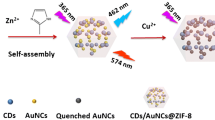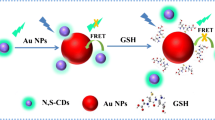Abstract
A synchronous fluorescence spectroscopy (SFS) sensor for pethidine detection is described based on UiO-66 metal–organic frameworks (MOFs) modified with N-doped carbon quantum dots (N-CQDs) embedded in hydrogel nanocomposites. Benefitting from the inovative design of the doping method in the carbonaceous structure, N-CQDs were successfully deposited in the pores of the UiO-66 network. Then, N-CQDs were employed as a sensitive segment toward the target molecules. UiO-66 was used for sensitive and selective sensing of the bonding interactions between N-CQDs and pethidine so that the electron transfer process from UiO-66 to the pethidine-N-CQD complex results in quenching the SFS intensity of UiO-66. To embed the stable and suitable sensing interface for pethidine assessment, the designed nanomaterial was inserted into the hydrogel network. This nanocomposite hydrogel showed two well-resolved emission peaks at 300 nm and 350 nm under ∆λ = 70, which corresponded to N-CQDs and UiO-66, respectively. The SFS sensing platform was employed for ratiometric detection of pethidine with a low limit of detection of 0.002 μg mL−1 over a wide concentration range from 0.005 to 1.0 μg mL−1. The accurate monitoring of pethidine with a good recovery of 90.8–101.5% indicated their independency from matrix effects for pethidine detection in human plasma being a complicated biological matrix.
Graphical abstract
Scheme 1. General procedure for synthesizing N-CQDs@UiO-66/PVA hydrogel-based nanoprobe and its application for pethidine determination








Similar content being viewed by others
Data availability
The work is supported by Tabriz University of Medical Science under grant number of 68133.
References
Bosilkovska M, Walder B, Besson M, Daali Y, Desmeules J (2012) Analgesics in patients with hepatic impairment. Drugs 72(12):1645–1669. https://doi.org/10.2165/11635500-000000000-00000
Min Y, Tun T, Linn YH, Aye NN, Win NHH (2019) Utilization, availability of analgesics and quality of pain control for post-operative pain in surgical patients. Drugs Ther Perspect 35(2):93–9. https://doi.org/10.1007/s40267-018-0582-3
Kul A, Ozdemir M, Sagirli O (2020) Determination of pethidine of abuse and relevant metabolite norpethidine in urine by ultra-performance liquid chromatography-tandem mass spectrometry. J Pharm Biomed Anal 186:113320
Cao J, Du Y, Wang Y-j, Wu B, Jia J, Wei Z-w, Yun K-m, Liang W, Wang Y, Sun J (2018) Pharmacokinetics of meperidine (pethidine) in rabbit oral fluid: correlation with plasma concentrations after controlled administration. Int J Pharm Sci 73(6):324–328. https://doi.org/10.1691/ph.2018.8014
Farsam H, Nadjari-Moghaddam M (1984) Spectrophotometric determination of meperidine hydrochloride in pharmaceutical preparations by complexation with bromocresol green. J Pharm Biomed Anal 2(3–4):543–547
Qiu Q, Chen H, Ying S, Sharif S, You Z, Wang Y et al (2019) Simultaneous fluorometric determination of the DNAs of Salmonella enterica, Listeria monocytogenes and Vibrio parahemolyticus by using an ultrathin metal-organic framework (type Cu-TCPP). MCA 186(2):1–7. https://doi.org/10.1007/s00604-019-3226-y
Xiao H, Li P, Zhang W, Tang B (2016) An ultrasensitive near-infrared ratiometric fluorescent probe for imaging mitochondrial polarity in live cells and in vivo. Chem Sci 7(2):1588–1593. https://doi.org/10.1039/C5SC04099J
Guo M, Chi J, Li Y, Waterhouse GI, Ai S, Hou J et al (2020) Fluorometric determination of mercury (II) based on dual-emission metal-organic frameworks incorporating carbon dots and gold nanoclusters. Microchim Acta 187:1–8
Sun H, Cong S, Zheng Z, Wang Z, Chen Z, Zhao Z (2018) Metal-organic frameworks as surface enhanced Raman scattering substrates with high tailorability. J Am Chem Soc 141(2):870–878. https://doi.org/10.1021/jacs.8b09414
Chang J, Wang X, Wang J, Li H, Li F (2019) Nucleic acid-functionalized metal–organic framework-based homogeneous electrochemical biosensor for simultaneous detection of multiple tumor biomarkers. Anal Chem 91(5):3604–3610. https://doi.org/10.1021/acs.analchem.8b05599
Karimzadeh Z, Javanbakht S, Namazi H (2019) Carboxymethylcellulose/MOF-5/graphene oxide bio-nanocomposite as antibacterial drug nanocarrier agent. BioImpacts: BI 9(1):5. https://doi.org/10.15171/bi.2019.02
Qin S-J, Yan B (2018) Dual-emissive ratiometric fluorescent probe based on Eu3+/C-dots@ MOF hybrids for the biomarker diaminotoluene sensing. Sens Actuators B Chem 272:510–517. https://doi.org/10.1016/j.snb.2018.06.018
Yang L, Song Y, Wang L (2020) Multi-emission metal–organic framework composites for multicomponent ratiometric fluorescence sensing: recent developments and future challenges. J Mater Chem B 8(16):3292–3315. https://doi.org/10.1039/C9TB01931F
Abdolmohammad-Zadeh H, Ahmadian F (2021) A fluorescent biosensor based on graphene quantum dots/zirconium-based metal-organic framework nanocomposite as a peroxidase mimic for cholesterol monitoring in human serum. Microchem J 164:106001
Yang J-M, Hu X-W, Liu Y-X, Zhang W (2019) Fabrication of a carbon quantum dots-immobilized zirconium-based metal-organic framework composite fluorescence sensor for highly sensitive detection of 4-nitrophenol. Microporous Mesoporous Mater 274:149–154. https://doi.org/10.1016/j.micromeso.2018.07.042
Jalili R, Khataee A, Rashidi MR, Luque R (2019) Dual-colored carbon dot encapsulated metal-organic framework for ratiometric detection of glutathione. Sens Actuators B 297(8)
Luo X, Huang G, Li Y, Guo J, Chen X, Tan Y et al (2022) Dual-modes of ratiometric fluorescent and smartphone-integrated colorimetric detection of glyphosate by carbon dots encapsulated porphyrin metal–organic frameworks. Appl Surf Sci 602:154368
Zhou M, Guo J, Yang C (2018) Ratiometric fluorescence sensor for Fe3+ ions detection based on quantum dot-doped hydrogel optical fiber. Sens Actuators B Chem 264:52–58. https://doi.org/10.1016/j.snb.2018.02.119
Guo J, Zhou M, Yang C (2017) Fluorescent hydrogel waveguide for on-site detection of heavy metal ions. Sci Rep 7(1):1–8. https://doi.org/10.1038/s41598-017-08353-8
Karimzadeh Z, Mahmoudpour M, Rahimpour E, Jouyban A (2022) Nanomaterial based PVA nanocomposite hydrogels for biomedical sensing: Advances toward designing the ideal flexible/wearable nanoprobes. Adv Colloid Interface Sci 305:102705. https://doi.org/10.1016/j.cis.2022.102705
Ruiz-Palomero C, Soriano ML, Benitez-Martinez S, Valcarcel M (2017) Photoluminescent sensing hydrogel platform based on the combination of nanocellulose and S, N-codoped graphene quantum dots. Sens Actuators B Chem 245:946–953. https://doi.org/10.1016/j.snb.2017.02.006
Wang C, Ding Y, Bi X, Luo J, Wang G, Lin Y (2018) Carbon quantum dots-Ag nanoparticle complex as a highly sensitive “turn-on” fluorescent probe for hydrogen sulfide: a DFT/TD-DFT study of electronic transitions and mechanism of sensing. Sens Actuators B Chem 264(404–409):9. https://doi.org/10.1016/j.snb.2018.02.186
Karimzadeh Z, Jouyban A, Ostadi A, Gharakhani A, Rahimpour E (2022) A sensitive determination of morphine in plasma using AuNPs@UiO-66/PVA hydrogel as an advanced optical scaffold. Analytica Chimica Acta 340252. https://doi.org/10.1016/j.aca.2022.340252
Feng J-f, Gao S-y, Shi J, Liu T-f, Cao R (2018) C-QDs@ UiO-66-(COOH) 2 composite film via electrophoretic deposition for temperature sensing. Inorg Chem 57(5):2447–2454. https://doi.org/10.1021/acs.inorgchem.7b02595
Hamidi M, Azadi A, Rafiei P (2008) Hydrogel nanoparticles in drug delivery. Adv Drug Deliv Rev 60(15):1638–1649. https://doi.org/10.1016/j.addr.2008.08.002
Zhao Y, Liu B, Pan L, Yu G (2013) 3D nanostructured conductive polymer hydrogels for high-performance electrochemical devices. Energy Environ Sci 6(10):2856–2870. https://doi.org/10.1039/C3EE40997J
Bahram M, Hoseinzadeh F, Farhadi K, Saadat M, Najafi-Moghaddam P, Afkhami A (2014) Synthesis of gold nanoparticles using pH-sensitive hydrogel and its application for colorimetric determination of acetaminophen, ascorbic acid and folic acid. Colloids Surf A Physicochem Eng 441:517–524. https://doi.org/10.1016/j.colsurfa.2013.09.024
Abu-Shawish HM, Abu Ghalwa N, Khraish GI, Hammad J (2011) A new potentiometric sensor for determination of pethidine hydrochloride in ampoules and urine. Am J Anal Chem 2(1). https://doi.org/10.4236/ajac.2011.21006
Ishii A, Tanaka M, Kurihara R, Watanabe-Suzuki K, Kumazawa T, Seno H, Suzuki O, Katsumata Y (2003) Sensitive determination of pethidine in body fluids by gas chromatography–tandem mass spectrometry. J Chromatogr B 792(1):117–121. https://doi.org/10.1016/S1570-0232(03)00132-6
Han B, Du Y, Wang E (2008) Simultaneous determination of pethidine and methadone by capillary electrophoresis with electrochemiluminescence detection of tris (2, 2′-bipyridyl) ruthenium (II). Microchem J 89(2):137–141. https://doi.org/10.1016/j.microc.2008.01.007
Liu Z-H, Wen M-L, Yao Y, Xiong J (2000) Plastic membrane electrode for the potentiometric determination of pethidine hydrochloride in pharmaceutical preparations. Fresenius J Anal Chem 368(4):335–337. https://doi.org/10.1007/s002160000463
Khorablou Z, Shahdost-Fard F, Razmi H (2022) Voltammetric determination of pethidine in biofluids at a carbon cloth electrode modified by carbon selenide nanofilm. Talanta 239:123131. https://doi.org/10.1016/j.talanta.2021.123131
Zhang M-L, Hasi W-L-J, Lin X, Zhao X-R, Lou X-T, Han S-q-g-w, Lin D-Y, Lu Z-W (2015) Rapid and simple detection of pethidine hydrochloride injection using surface-enhanced Raman spectroscopy based on silver aggregates. Anal Methods 7(19):8241–8247. https://doi.org/10.1039/C5AY01882J
Shahinfard H, Shabani-Nooshabadi M, Reisi-Vanani A, Ansarinejad H (2022) A novel platform based on CoMn2O4-rGO/1-ethyl-3-methylimidazolium chloride modified carbon paste electrode for voltammetric detection of pethidine in the presence morphine and olanzapine. Chemosphere 301:134710. https://doi.org/10.1016/j.chemosphere.2022.134710
Myung S-W, Kim S, Park J-H, Kim M, Lee J-C, Kim T-J (1999) Solid-phase microextraction for the determination of pethidine and methadone in human urine using gas chromatography with nitrogen–phosphorus detection. Analyst 124(9):1283–1286
Acknowledgements
Research reported in this publication is a part of Z. Karimzadeh’s Ph.D. thesis submitted to the Faculty of Pharmacy, Tabriz University of Medical Sciences, Tabriz, Iran.
Funding
The work is financially supported by the Pharmaceutical Analysis Research Center under grant number 68133.
Author information
Authors and Affiliations
Corresponding author
Ethics declarations
Conflict of interest
The authors declare no competing interests.
Additional information
Publisher's note
Springer Nature remains neutral with regard to jurisdictional claims in published maps and institutional affiliations.
Supplementary Information
Below is the link to the electronic supplementary material.
Rights and permissions
Springer Nature or its licensor (e.g. a society or other partner) holds exclusive rights to this article under a publishing agreement with the author(s) or other rightsholder(s); author self-archiving of the accepted manuscript version of this article is solely governed by the terms of such publishing agreement and applicable law.
About this article
Cite this article
Karimzadeh, Z., Gharekhani, A., Rahimpour, E. et al. Dual-emission ratiometric fluorescent probe based on N-doped CQDs@UiO-66/PVA nanocomposite hydrogel for quantification of pethidine in human plasma. Microchim Acta 190, 128 (2023). https://doi.org/10.1007/s00604-023-05703-4
Received:
Accepted:
Published:
DOI: https://doi.org/10.1007/s00604-023-05703-4




